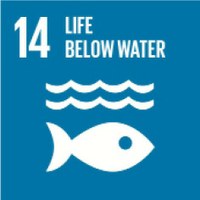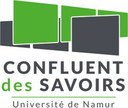Life below water
 Research
Research
All the "Life below water" publication on the UNamur research portal.
Education
- Aquatic ecology field courses for biology students
- Module of the BOE Master in Ecology and Management of Aquatic Environments proposed and managed by UNamur
- Scientific mediation programmes on water by the Confluent of Knowledge
More information on sustainable education at UNamur...
Social impact and actions
Corporate initiatives
Awareness-raising activities
|
Exhibition « Health of our rivers at risk?” The exhibition, organised by the Confluent des Savoirs (CDS), the scientific mediation unit of UNamur, allowed the discovery of the stages of the European project DIADeM. The tour was divided into two parts, one for adults and the other for young people (9-14 years old - adapted to school levels from 3rd primary to 2nd secondary). As part of the Festival International Nature Namur, the booklet for the youth section was available free of charge. More info (in French) here... |
 |
|
Exhibition « Water in all its forms” Staff members and students were invited to exhibit their best photos on the theme of water at Quai 22 as part of the 27th edition of the Festival International Nature de Namur (FINN). Read more (in French) here... |
 |
Ponds at the Haugimont Estate
|
Situated in the heart of the Condruzian countryside, the Haugimont Estate lies in the commune of Gesves, 18 km south-east of Namur. Since 1978, it has been an exceptional teaching and research centre for students and scientists from the University of Namur. It is also open to the public and to schools for training, discovery and leisure activities. Project: the creation of 6 ponds, in collaboration with SPW Research. |
 |
Collaborations and partnerships
Siensano - COVWWSURV – National surveillance of SARS-CoV-2 and its variants in sewage
Together with UAntwerp and UGhent, the University of Namur takes part in the project "COVWWSURV. It concerns the implementation of a surveillance system for coronavirus (SARS-CoV-2) through the analysis of sewage, the objective being the early detection of any significant evolution of the circulation of the virus in the population. This surveillance system will cover approximately 45% of the Belgian population, by means of the analysis of the sewage entering the wastewater treatment plant, at a rate of two times per week.
A new partnership with the University of Lorraine
The URBE and UR AFPA are both experts in aquaculture. The aim of the project is to understand the effects of domestication on the reproduction and welfare of new species in aquaculture. The chosen model is the Zebra Fish. The fish will arrive from Bangladesh and will be in the wild. But we don't eat Zebra Fish, do we? So, why was this model chosen? First of all, because their genome is well-known and a lot of bibliographic resources are available. Then, it is a species which reproduces quickly (a few months are enough to obtain a new generation). This enables to quickly analyze its resistance to stress and its reproduction in captivity. It should also be noted that the study plans to let the fish develop without making any selection, as is generally the case in farms. In this way, we can see whether domestication syndromes appear naturally, including phenotypic changes (appearance, morphology, levels of the stress hormone called cortisol, etc.). To learn more...
River clean up operation
The University of Namur took part to the river cleanup operation organized by the "Capitainerie" of Jambes.
Research institutes and units
Institute of Life, Earth and Environment (ILEE)
|
Research at the Institute of Life, Earth and Environment (ILEE) is relevant to several of the United Nations' Sustainable Development Goals (SDGs). For example, we study the impact of multiple stressors (chemical, physical or pathogenic) and/or pollutants (pesticides, pharmaceuticals, endocrine disruptors, neurotoxins, atmospheric residues) on organisms but also on ecosystems, and solutions are sought to strengthen their resistance and resilience and/or limit harmful products (e.g. immuno-stimulation, search for alternative pharmaceuticals). Furthermore, by prospecting and characterising geological resources (water, metals and other raw materials) and by integrating human use over the centuries, from Antiquity to the current Anthropocene, ILEE contributes to the sustainable management of natural resources, including architecture and art. The transition to a more sustainable agriculture is investigated through the concept of ecosystem services via mapping, modelling and integrated assessment. The consequences of climate change on human migration or the interactions between the different agents responsible for the transmission of vector-borne and zoonotic diseases are also at the heart of ILEE's research. Read more... |
 |
Environmental and Evolutionary Biology Research Unit (URBE)
The URBE is dedicated to the study of aquatic organisms and their interactions with the environment. It combines comparative biology (several species studied) and integrative biology (several levels of biological integration). Thus, the research teams are structured around four main areas, ranging from the study of genomes to that of ecosystems, via organisms and populations. State-of-the-art laboratory techniques are combined with field studies in various aquatic ecosystems. The Unit is closely involved in student training, notably via the Master's degree in Organismal Biology and Ecology co-organised with UCL. More about URBE (in French) here...
Ecobim international conference – Long-term impacts of pollution on humans and ecosystems
Today, the pollution of oceans, rivers and soils is considered to be a major factor in global change, on a par with global warming and the loss of biodiversity. The thousands of chemical substances (pesticides, microplastics, metals, etc.) continually discharged into natural habitats have long-term impacts on both human health and ecosystems. The aim of this conference is to hear from a number of scientists about the long-term risks of pollution. Find out more about the conference (in French)...
Spin-off
e-biom
| Created with the support of the FIRST Spin-off programme of the SPW Research, e-biom is a biological and environmental consultancy company associated with a multidisciplinary laboratory specialising in bio-monitoring, ecological and biological studies. More about e-biom... |  |
TRAQUA
| Created with the support of the FIRST Spin-off programme of the SPW Research, the TRAQUA spin-off is a research consultancy specialising in water flow analysis and monitoring techniques. We offer technological solutions and customised expertise for all hydrogeological or hydrological problems (analysis, diagnosis, monitoring). More about TRAQUA... |  |















